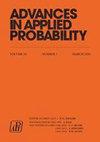Optimally Stopping at a Given Distance from the Ultimate Supremum of a Spectrally Negative Lévy Process
IF 1.2
4区 数学
Q3 STATISTICS & PROBABILITY
引用次数: 0
Abstract
Abstract We consider the optimal prediction problem of stopping a spectrally negative Lévy process as close as possible to a given distance $b \geq 0$ from its ultimate supremum, under a squared-error penalty function. Under some mild conditions, the solution is fully and explicitly characterised in terms of scale functions. We find that the solution has an interesting non-trivial structure: if b is larger than a certain threshold then it is optimal to stop as soon as the difference between the running supremum and the position of the process exceeds a certain level (less than b), while if b is smaller than this threshold then it is optimal to stop immediately (independent of the running supremum and position of the process). We also present some examples.一个特殊负Lévy过程在距极限上模给定距离处的最优停止
摘要考虑了在平方误差惩罚函数下,在离光谱负的lsamvy过程的最终极值尽可能近的距离$b \geq 0$处停止它的最优预测问题。在一些温和的条件下,解被充分和明确地描述为尺度函数。我们发现该解决方案具有一个有趣的非平凡结构:如果b大于某个阈值,则在运行最高和进程位置之间的差值超过一定水平(小于b)时立即停止是最优的,而如果b小于该阈值,则立即停止是最优的(与运行最高和进程位置无关)。我们还举了一些例子。
本文章由计算机程序翻译,如有差异,请以英文原文为准。
求助全文
约1分钟内获得全文
求助全文
来源期刊

Advances in Applied Probability
数学-统计学与概率论
CiteScore
2.00
自引率
0.00%
发文量
64
审稿时长
6-12 weeks
期刊介绍:
The Advances in Applied Probability has been published by the Applied Probability Trust for over four decades, and is a companion publication to the Journal of Applied Probability. It contains mathematical and scientific papers of interest to applied probabilists, with emphasis on applications in a broad spectrum of disciplines, including the biosciences, operations research, telecommunications, computer science, engineering, epidemiology, financial mathematics, the physical and social sciences, and any field where stochastic modeling is used.
A submission to Applied Probability represents a submission that may, at the Editor-in-Chief’s discretion, appear in either the Journal of Applied Probability or the Advances in Applied Probability. Typically, shorter papers appear in the Journal, with longer contributions appearing in the Advances.
 求助内容:
求助内容: 应助结果提醒方式:
应助结果提醒方式:


